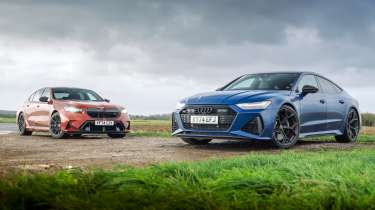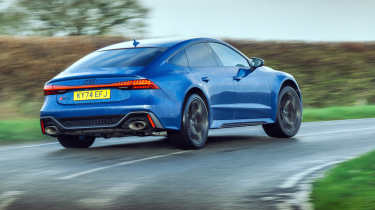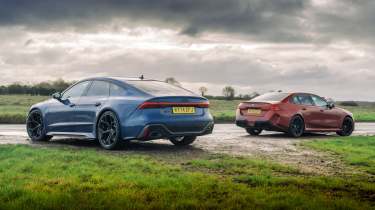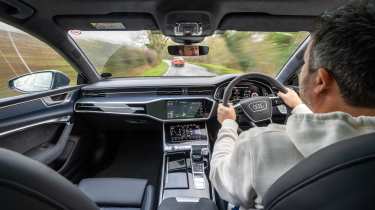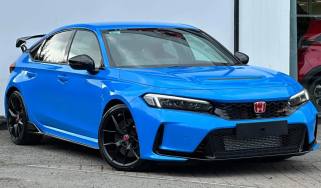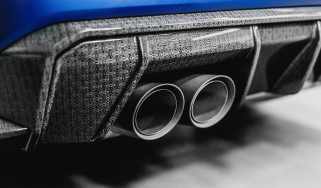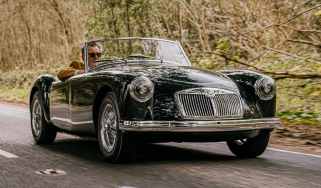Audi RS7 v BMW M5 – pure V8 battles heavy hybrid
If you prefer your all-wheel-drive supersaloon to be powered purely by combustion, there’s still Audi’s RS7 Sportback to consider. But is it being left behind by the hybrid set?
Let’s start with the car park test. Sit the RS7 next to the M5 and the Audi’s jacked physique knocks the slab-sided BMW into the middle of next week. It’s a similar story inside. The M5’s huge widescreen display is ugly, but it’s nothing compared to the broad illuminated plastic band that runs the full width of the dashboard and halfway along the front door cards for a provincial niteclub vibe.
The gimmick-free RS7 is simple but sombre; just as comfortable but more mature and of higher quality. The separation between main instrument display and central infotainment screen is less dominant and much nicer when driving at night.
> BMW M5 (G90) v Porsche Panamera Turbo E‑Hybrid – 700bhp hybrid super saloons go head-to-head
Start them up and the Audi’s V8 sounds richer and more impressive than the BMW’s, though to be fair to the G90 the previous M5 was no great shakes in this regard. Once underway both employ a degree of augmentation to what you hear in the cockpit, but where the Audi sounds authentic, the BMW can be a bit Sega Rally.
The RS7’s ICE-only 621bhp and 627lb ft compare well against the M5’s hybrid-assisted 717bhp and 737lb ft, especially when you factor in the official weights of 2065kg and 2435kg respectively. Power-to-weight falls slightly in the Audi’s favour, at 306bhp/ton versus 299. Claimed performance is very close too, the RS7 capable of 0-62mph in 3.4sec, the M5 taking 3.5sec.
Both cars require you to explore a vast range of dynamic settings. Of the pair the M5 is the most responsive to changes, but it takes a while to zero in on your preferred combination of Drivetrain, Energy Recovery, Drivelogic, Chassis, Steering, Brake, M xDrive, M Sound and ESC settings. Then the road changes and you begin to think about whether the car would now feel better with the Chassis back to Comfort. Or weather conditions improve and you want the added playfulness of xDrive in 4WD Sport.
The most nuanced modes are those for steering and brakes, which both offer a choice of Comfort or Sport. Having the steering in Sport is transformational, relaxed turn-in response exchanged for a measured increase in keenness and a welcome gain in agility. Similarly, having the brakes in Sport brings more bite at the top of the pedal, but overall feel is dependent on which Energy Recovery mode you’ve selected: the added drag of a more aggressive regen mode can get in the way of things.
The real game-changer – and the big advantage over the Audi – is xDrive. Conditions are patchy wet during our test, which places more emphasis on grip and traction. To fully explore the M5’s choice of 4WD, 4WD Sport and 2WD modes also requires you to adjust (or rather relax) the ESC. This might be offputting to some, but it effectively gives you three very different cars to play with.
4WD is steadfast and confidence-inspiring, but because there’s a very mild sense of rotation from the rear – thanks to rear-wheel steer and an active rear diff – it doesn’t feel inert. 4WD Sport is surprisingly playful and can feel rear-drive through certain corners, though this is partly due to the ESC change. Switching to 2WD is not something to be done lightly, especially if the conditions are less than bone dry, for the M5 has the torque to annihilate its rear tyres. It just feels like a bit of a liability and loses much of the poise you can enjoy in 4WD Sport, though warmer temperatures would doubtless make more sense of it.
The RS7 also has a choice of modes and settings. They don’t go quite so granular and the changes don’t make such fundamental shifts in the car’s character and behaviour, but they are meaningful – the Dynamic setting for the Sport Differential especially, which dials in a welcome degree of agility.
Assuming you’ve found the ideal combo in both cars, which would you rather drive? In almost every circumstance the M5 offers the best experience and highest level of capability. The hybrid drive complements the V8 very nicely, with a massive, rounded shove of battery assistance from low rpm that blends brilliantly with the V8 as you extend it beyond the mid-range. The RS7 is no slouch, but the sensation isn’t as impressive.
It’s the way the M5 steers and tackles corners that leaves the Audi wanting, the BMW offering more connection and precision and ultimately more enjoyment from feeling its chassis working. That’s not to say the RS7 is a disappointment. The way it gets you into and out of a corner – the sense of it finding front-end grip then pausing slightly to square the apex, hunker down and punch out onto the straight – is a real Audi hallmark.
In objective terms the M5 is the better car. It’s more capable, more polished and much more entertaining to drive. If only BMW’s styling team could disguise its bulk as brilliantly as the chassis engineers have.
Specs
| BMW M5 | Audi RS7 | |
| Engine | V8, 4395cc, twin-turbo, plus 145kW e-motor | V8, 3996cc, twin-turbo |
| Combined power | 717bhp | 621bhp |
| Torque | 737lb ft | 627lb ft |
| Weight | 2435kg | 2065kg |
| Power-to-weight | 299bhp/ton | 306bhp/ton |
| 0-62mph | 3.5sec | 3.4sec |
| Top speed | 190mph (with M Driver’s Package) | 174mph |
| Basic price | £111,405 (£131,950 as tested) | £121,105 |
This story was first featured in evo issue 330.
